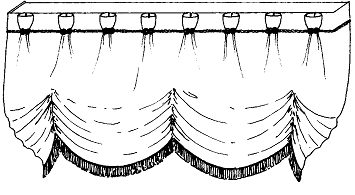
| Back to index Next Page Previous Page |
© Copyright Merrick & Day
| NOTE: we have simplified the fabric quantity formulas to make it easy to work on your calculator by using the following symbols: + (plus) and x (times). |
CURTAINS
| 1 | Length of the track or the pole |
| 2 | Curtain fullness ratio |
| 3 | Usable width of the fabric: On plain fabric this is the width minus seam allowances (allow approximately 1.5cm (1/2in) seam allowance on each side) On patterned fabric, match the pattern first at the sides. For the repeat, measure from point to point where the motif for pattern starts again. |
| 4 | Fabric cut drop: On plain fabric work out the finished length
of the curtain from your window measurements + heading and hem allowances. See
chart below. On patterned fabric take the fabric cut drop and divide by the
pattern repeat. Round up, never round down, and multiply the result by the
amount of the pattern repeat. For a drop pattern see p119. |
| This FABRIC QUANTITIES table will show you how to find the exact quantities you need for the Almost Instant Formula, above. The fullness ratio gives you the number of widths, add the allowances to the length of each panel. | |||||||||||||||||||||||||
|
|
||||||||||||||||||||||||
VALANCES
| 1 | Finished width of valance - that is, the measurement around pelmet board or valance rail including sides. |
| 2 | Heading fullness ratio. |
| 3 | Usable width of the fabric. |
| 4 | Fabric cut drop = finished depth of valance + heading and hem allowance |
Do your calculations as given in the Almost Instant Fabric Formula
SERPENTINED VALANCES
A graceful proportion is for the shortest and longest measurements to be 1/6 and 1/5 respectively of the finished curtain length. Calculate the fabric quantities as for a straight valance based on the longest measurement.
ARCHED VALANCES
The finished depth of the valance at the shortest point should be 1/6 or 1/5 of the curtain length. The longest point at the sides is determined by the design. If the longest point hangs over the curtain stack back area, there will be no loss of light.
Cut drop = deepest measurement of valance + a heading and hem allowance. Adjust the cut drop for pattern repeats if necessary.
PELMETS
The finished width of a flat pelmet is the measurement around the pelmet board or rails including the sides. Divide this figure by the usable width of the fabric to establish the number of widths you will need.
Cut drop = deepest measurement of pelmet + 15cm (6in) turning allowance.
INFORMAL SCARF DRAPERY, SWAGS AND TAILS
For estimating quantities, see p166 and p182 respectively in The Encyclopaedia of Curtains.
FABRIC TRIMS
For contrast edging, frills and fabric trims, see Individual instructions in Finishing Touches pp l50-65 in The Encyclopaedia of Curtains. These apparently minor quantities will add up to more yardage than you imagine; never assume you will be able to find enough from leftover fabric. For piping and binding cut on the cross, see pl21 in The Encyclopaedia of Curtains.
BED CURTAINS
These are estimated in the same way as window curtains. For specific details, see p213 in The Encyclopaedia of Curtains.
TABLECLOTHS
For round tablecloths, see p218 in The Encyclopaedia of Curtains. Obviously there will be some wastage with round cloths, but you can use the corners for the smaller fabric trims, applique on cushions and so on.
 An Austrian blind with a goblet pleated heading and drop down sides |
BLINDS ROLLER and ROMAN BLINDS
Will need only the flat measurement across the window, see ppl99-200 in The Encyclopaedia of Curtains.
GATHERED AUSTRIAN BLINDS
Vary in fullness from 1.5 – 2.5 according to the heading required. They are usually made a little overlong so that you can have pretty scalloped hems even when they are dropped down.
FESTOON BLINDS
As above, but they also have extra vertical fullness; for more details see pp203-4 in The Encyclopaedia of Curtains.
Professional tip
| Back to index Next Page Previous Page |